2007 CHEVROLET SILVERADO fuel cap
[x] Cancel search: fuel capPage 495 of 684
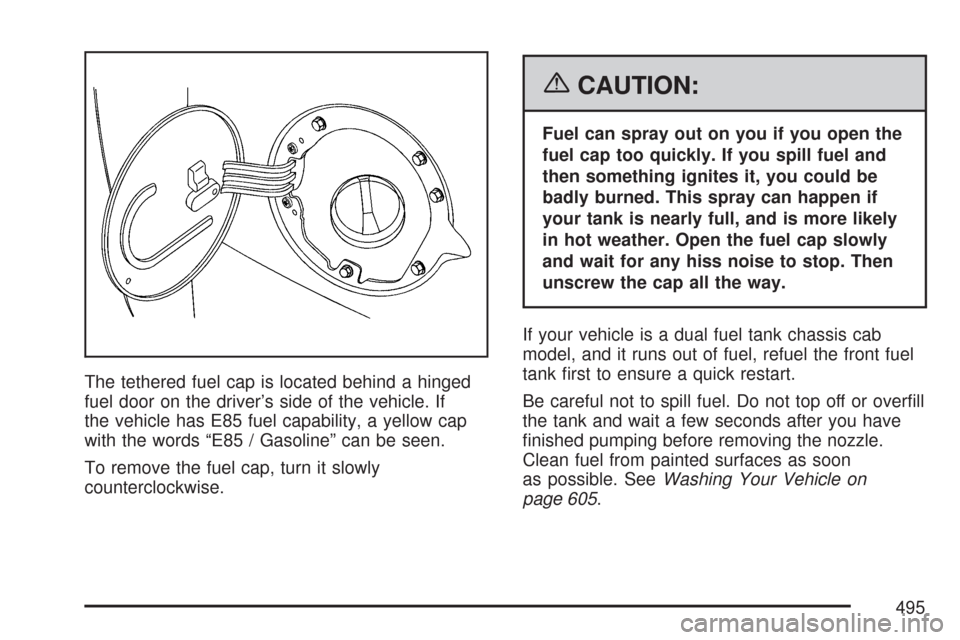
The tethered fuel cap is located behind a hinged
fuel door on the driver’s side of the vehicle. If
the vehicle has E85 fuel capability, a yellow cap
with the words “E85 / Gasoline” can be seen.
To remove the fuel cap, turn it slowly
counterclockwise.
{CAUTION:
Fuel can spray out on you if you open the
fuel cap too quickly. If you spill fuel and
then something ignites it, you could be
badly burned. This spray can happen if
your tank is nearly full, and is more likely
in hot weather. Open the fuel cap slowly
and wait for any hiss noise to stop. Then
unscrew the cap all the way.
If your vehicle is a dual fuel tank chassis cab
model, and it runs out of fuel, refuel the front fuel
tank �rst to ensure a quick restart.
Be careful not to spill fuel. Do not top off or over�ll
the tank and wait a few seconds after you have
�nished pumping before removing the nozzle.
Clean fuel from painted surfaces as soon
as possible. SeeWashing Your Vehicle on
page 605.
495
Page 496 of 684
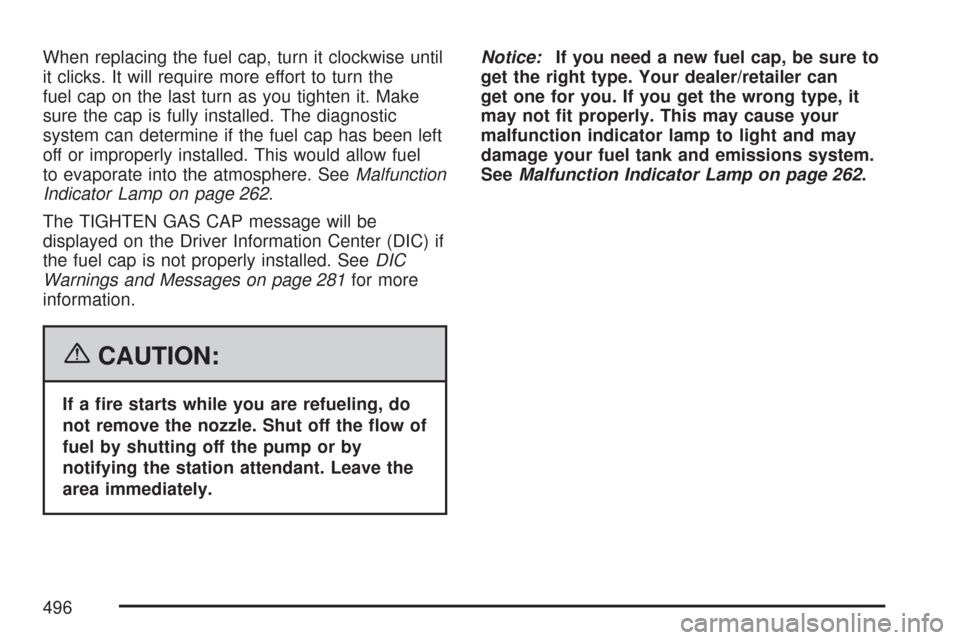
When replacing the fuel cap, turn it clockwise until
it clicks. It will require more effort to turn the
fuel cap on the last turn as you tighten it. Make
sure the cap is fully installed. The diagnostic
system can determine if the fuel cap has been left
off or improperly installed. This would allow fuel
to evaporate into the atmosphere. SeeMalfunction
Indicator Lamp on page 262.
The TIGHTEN GAS CAP message will be
displayed on the Driver Information Center (DIC) if
the fuel cap is not properly installed. SeeDIC
Warnings and Messages on page 281for more
information.
{CAUTION:
If a �re starts while you are refueling, do
not remove the nozzle. Shut off the �ow of
fuel by shutting off the pump or by
notifying the station attendant. Leave the
area immediately.Notice:If you need a new fuel cap, be sure to
get the right type. Your dealer/retailer can
get one for you. If you get the wrong type, it
may not �t properly. This may cause your
malfunction indicator lamp to light and may
damage your fuel tank and emissions system.
SeeMalfunction Indicator Lamp on page 262.
496
Page 558 of 684

(E) Rim Diameter:Diameter of the wheel in
inches.
(F) Service Description:The service description
indicates the load range and speed rating of a
tire. The load index can range from 1 to 279.
Speed ratings range from A to Z.
Tire Terminology and De�nitions
Air Pressure:The amount of air inside the tire
pressing outward on each square inch of the
tire. Air pressure is expressed in pounds
per square inch (psi) or kilopascal (kPa).
Accessory Weight:This means the combined
weight of optional accessories. Some examples of
optional accessories are, automatic transmission,
power steering, power brakes, power windows,
power seats, and air conditioning.
Aspect Ratio:The relationship of a tire’s height
to its width.
Belt:A rubber coated layer of cords that is
located between the plies and the tread. Cords
may be made from steel or other reinforcing
materials.Bead:The tire bead contains steel wires wrapped
by steel cords that hold the tire onto the rim.
Bias Ply Tire:A pneumatic tire in which the plies
are laid at alternate angles less than 90 degrees
to the centerline of the tread.
Cold Tire Pressure:The amount of air pressure
in a tire, measured in pounds per square inch (psi)
or kilopascals (kPa) before a tire has built up heat
from driving. SeeIn�ation - Tire Pressure on
page 561.
Curb Weight:This means the weight of a motor
vehicle with standard and optional equipment
including the maximum capacity of fuel, oil, and
coolant, but without passengers and cargo.
DOT Markings:A code molded into the sidewall
of a tire signifying that the tire is in compliance
with the U.S. Department of Transportation (DOT)
motor vehicle safety standards. The DOT code
includes the Tire Identi�cation Number (TIN),
an alphanumeric designator which can also identify
the tire manufacturer, production plant, brand,
and date of production.
GVWR:Gross Vehicle Weight Rating. See
Loading Your Vehicle on page 427.
558
Page 561 of 684
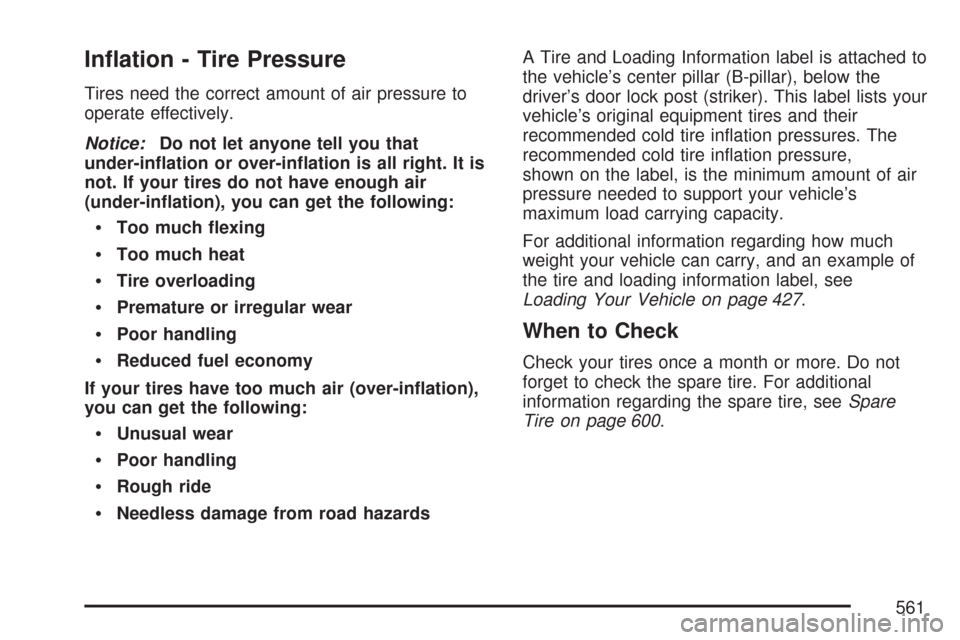
In�ation - Tire Pressure
Tires need the correct amount of air pressure to
operate effectively.
Notice:Do not let anyone tell you that
under-in�ation or over-in�ation is all right. It is
not. If your tires do not have enough air
(under-in�ation), you can get the following:
Too much �exing
Too much heat
Tire overloading
Premature or irregular wear
Poor handling
Reduced fuel economy
If your tires have too much air (over-in�ation),
you can get the following:
Unusual wear
Poor handling
Rough ride
Needless damage from road hazardsA Tire and Loading Information label is attached to
the vehicle’s center pillar (B-pillar), below the
driver’s door lock post (striker). This label lists your
vehicle’s original equipment tires and their
recommended cold tire in�ation pressures. The
recommended cold tire in�ation pressure,
shown on the label, is the minimum amount of air
pressure needed to support your vehicle’s
maximum load carrying capacity.
For additional information regarding how much
weight your vehicle can carry, and an example of
the tire and loading information label, see
Loading Your Vehicle on page 427.
When to Check
Check your tires once a month or more. Do not
forget to check the spare tire. For additional
information regarding the spare tire, seeSpare
Tire on page 600.
561
Page 621 of 684
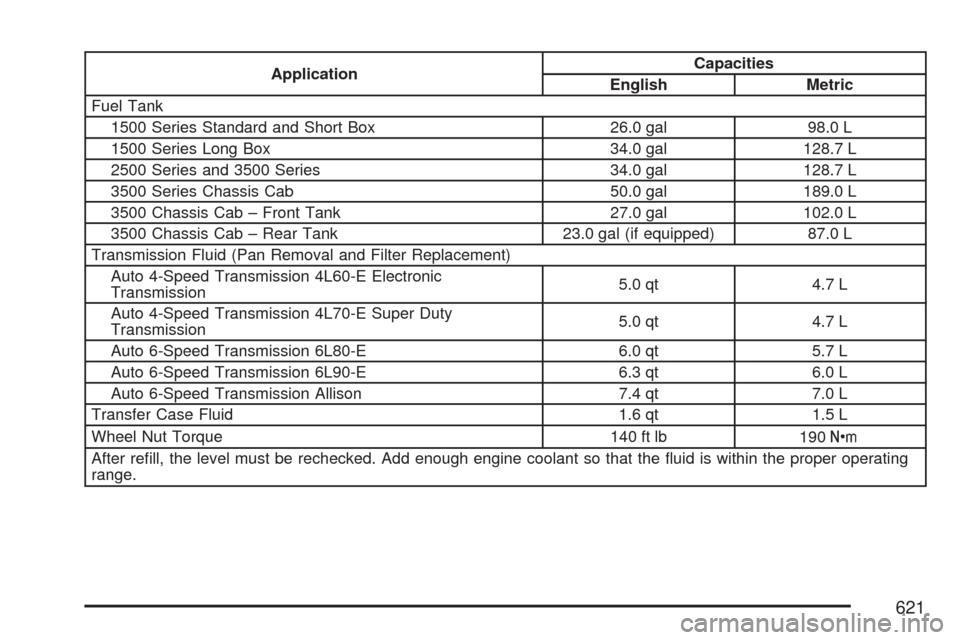
ApplicationCapacities
English Metric
Fuel Tank
1500 Series Standard and Short Box 26.0 gal 98.0 L
1500 Series Long Box 34.0 gal 128.7 L
2500 Series and 3500 Series 34.0 gal 128.7 L
3500 Series Chassis Cab 50.0 gal 189.0 L
3500 Chassis Cab – Front Tank 27.0 gal 102.0 L
3500 Chassis Cab – Rear Tank 23.0 gal (if equipped) 87.0 L
Transmission Fluid (Pan Removal and Filter Replacement)
Auto 4-Speed Transmission 4L60-E Electronic
Transmission5.0 qt 4.7 L
Auto 4-Speed Transmission 4L70-E Super Duty
Transmission5.0 qt 4.7 L
Auto 6-Speed Transmission 6L80-E 6.0 qt 5.7 L
Auto 6-Speed Transmission 6L90-E 6.3 qt 6.0 L
Auto 6-Speed Transmission Allison 7.4 qt 7.0 L
Transfer Case Fluid 1.6 qt 1.5 L
Wheel Nut Torque 140 ft lb
190Y
After re�ll, the level must be rechecked. Add enough engine coolant so that the �uid is within the proper operating
range.
621
Page 634 of 684

(e)Make sure the safety belt reminder light and all
your belts, buckles, latch plates, retractors, and
anchorages are working properly. Look for
any other loose or damaged safety belt system
parts. If you see anything that might keep a safety
belt system from doing its job, have it repaired.
Have any torn or frayed safety belts replaced. Also
look for any opened or broken airbag coverings,
and have them repaired or replaced. The
airbag system does not need regular maintenance.
(f)Lubricate all key lock cylinders, body door
hinges, hood latch assembly, secondary latch,
pivots, spring anchor, release pawl, tailgate hinges,
tailgate linkage, tailgate handle pivot points,
latch bolt, fuel door hinge, locks, and folding seat
hardware. More frequent lubrication may be
required when exposed to a corrosive
environment. Applying silicone grease on
weatherstrips with a clean cloth will make them
last longer, seal better, and not stick or squeak.
(g)Check vent hose at transfer case for kinks and
proper installation. Check to be sure vent hose
is unobstructed, clear, and free of debris.(h)Change automatic transmission �uid and �lter
if the vehicle Gross Vehicle Weight Rating
(GVWR) is over 8600 lbs or if the vehicle is mainly
driven under one or more of these conditions:
�In heavy city traffic where the outside
temperature regularly reaches 90°F (32°C) or
higher.
�In hilly or mountainous terrain.
�When doing frequent trailer towing.
�Uses such as found in taxi, police or delivery
service.
(i)Drain, �ush, and re�ll cooling system. This
service can be complex; you should have
your dealer perform this service. See Engine
Coolant on page 514 for what to use. Inspect
hoses. Clean radiator, condenser, pressure cap,
and �ller neck. Pressure test the cooling
system and pressure cap.
(j)A �uid loss in any vehicle system could indicate
a problem. Have the system inspected and
repaired and the �uid level checked. Add �uid
if needed.
634
Page 635 of 684
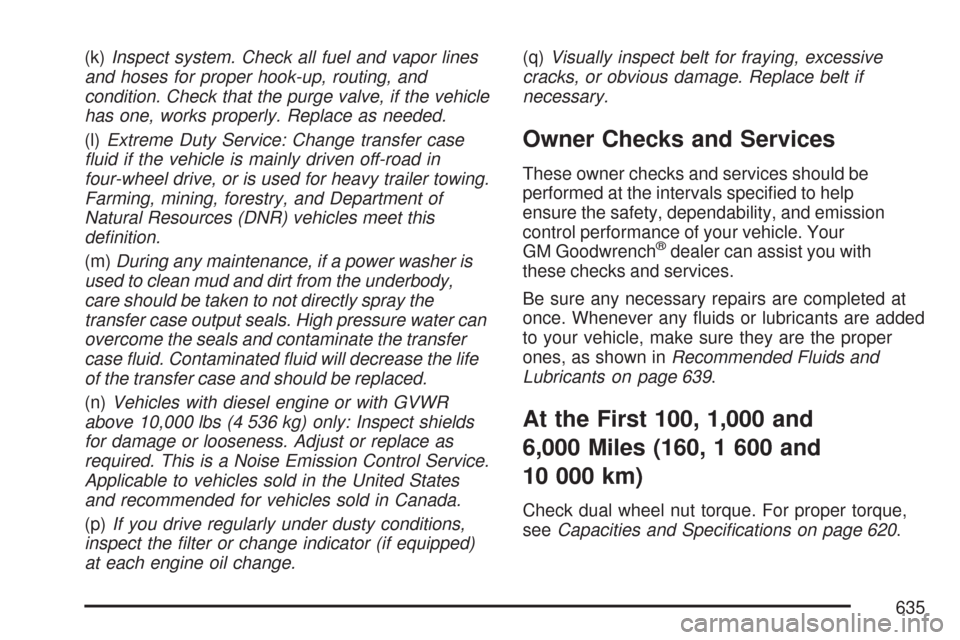
(k)Inspect system. Check all fuel and vapor lines
and hoses for proper hook-up, routing, and
condition. Check that the purge valve, if the vehicle
has one, works properly. Replace as needed.
(l)Extreme Duty Service: Change transfer case
�uid if the vehicle is mainly driven off-road in
four-wheel drive, or is used for heavy trailer towing.
Farming, mining, forestry, and Department of
Natural Resources (DNR) vehicles meet this
de�nition.
(m)During any maintenance, if a power washer is
used to clean mud and dirt from the underbody,
care should be taken to not directly spray the
transfer case output seals. High pressure water can
overcome the seals and contaminate the transfer
case �uid. Contaminated �uid will decrease the life
of the transfer case and should be replaced.
(n)Vehicles with diesel engine or with GVWR
above 10,000 lbs (4 536 kg) only: Inspect shields
for damage or looseness. Adjust or replace as
required. This is a Noise Emission Control Service.
Applicable to vehicles sold in the United States
and recommended for vehicles sold in Canada.
(p)If you drive regularly under dusty conditions,
inspect the �lter or change indicator (if equipped)
at each engine oil change.(q)Visually inspect belt for fraying, excessive
cracks, or obvious damage. Replace belt if
necessary.
Owner Checks and Services
These owner checks and services should be
performed at the intervals speci�ed to help
ensure the safety, dependability, and emission
control performance of your vehicle. Your
GM Goodwrench
®dealer can assist you with
these checks and services.
Be sure any necessary repairs are completed at
once. Whenever any �uids or lubricants are added
to your vehicle, make sure they are the proper
ones, as shown inRecommended Fluids and
Lubricants on page 639.
At the First 100, 1,000 and
6,000 Miles (160, 1 600 and
10 000 km)
Check dual wheel nut torque. For proper torque,
seeCapacities and Speci�cations on page 620.
635
Page 671 of 684
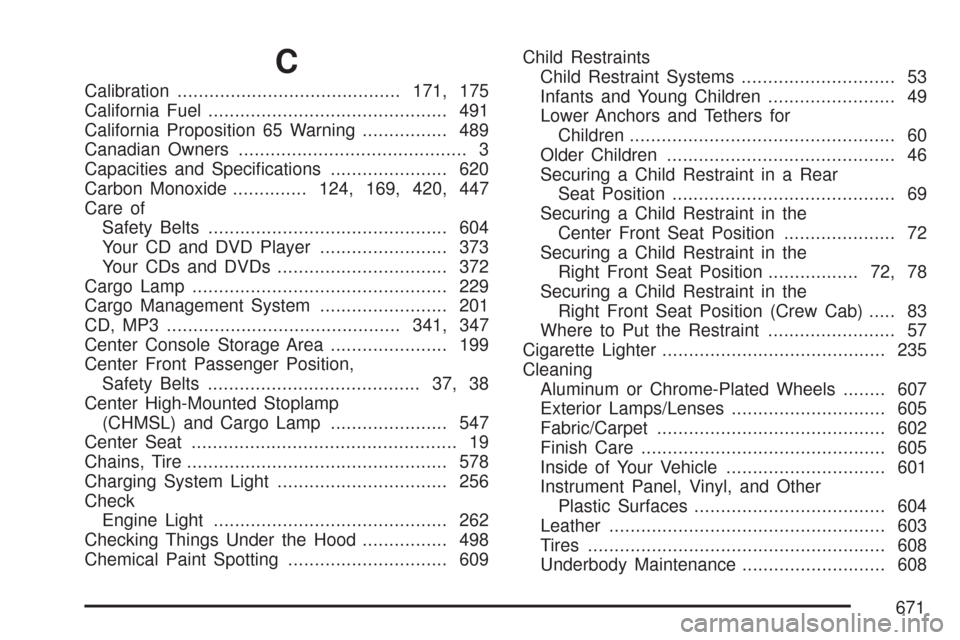
C
Calibration..........................................171, 175
California Fuel............................................. 491
California Proposition 65 Warning................ 489
Canadian Owners........................................... 3
Capacities and Speci�cations...................... 620
Carbon Monoxide..............124, 169, 420, 447
Care of
Safety Belts............................................. 604
Your CD and DVD Player........................ 373
Your CDs and DVDs................................ 372
Cargo Lamp................................................ 229
Cargo Management System........................ 201
CD, MP3 ............................................341, 347
Center Console Storage Area...................... 199
Center Front Passenger Position,
Safety Belts........................................ 37, 38
Center High-Mounted Stoplamp
(CHMSL) and Cargo Lamp...................... 547
Center Seat.................................................. 19
Chains, Tire................................................. 578
Charging System Light................................ 256
Check
Engine Light............................................ 262
Checking Things Under the Hood................ 498
Chemical Paint Spotting.............................. 609Child Restraints
Child Restraint Systems............................. 53
Infants and Young Children........................ 49
Lower Anchors and Tethers for
Children.................................................. 60
Older Children........................................... 46
Securing a Child Restraint in a Rear
Seat Position.......................................... 69
Securing a Child Restraint in the
Center Front Seat Position..................... 72
Securing a Child Restraint in the
Right Front Seat Position................. 72, 78
Securing a Child Restraint in the
Right Front Seat Position (Crew Cab)..... 83
Where to Put the Restraint........................ 57
Cigarette Lighter.......................................... 235
Cleaning
Aluminum or Chrome-Plated Wheels........ 607
Exterior Lamps/Lenses............................. 605
Fabric/Carpet........................................... 602
Finish Care.............................................. 605
Inside of Your Vehicle.............................. 601
Instrument Panel, Vinyl, and Other
Plastic Surfaces.................................... 604
Leather.................................................... 603
Tires........................................................ 608
Underbody Maintenance........................... 608
671